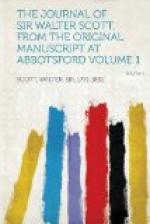September 6.—Went with Lady Compton to Glasgow, and had as pleasant a journey as the kindness, wit, and accomplishment of my companion could make it. Lady C. gives an admirable account of Rome, and the various strange characters she has met in foreign parts. I was much taken with some stories out of a romance called Manuscrit trouve a Saragosse, by a certain Count John Polowsky [Potocki?], a Pole. It seems betwixt the style of Cazotti, Count Hamilton and Le Sage. The Count was a toiler after supernatural secrets, an adept, and understood the cabbala. He put himself to death, with many odd circumstances, inferring derangement. I am to get a sight of the book if it be possible. At Glasgow (Buck’s Head) we met Mrs. Maclean Clephane and her two daughters, and there was much joy. After the dinner the ladies sung, particularly Anna Jane, who has more taste and talent of every kind than half the people going with great reputations on their backs.
A very pleasant day was paid for by a restless night.
September 7.—This day had calls from Lord Provost and Mr. Rutherford (William) with invitations, which I declined. Read in manuscript a very clever play (comedy) by Miss A.J. Clephane in the old style, which was very happily imitated. The plot was confused—too much taking and retaking of prisoners, but the dialogue was excellent.
Took leave of these dear friends, never perhaps to meet all together again, for two of us are old. Went down by steam to Colonel Campbell’s, Blythswood House, where I was most courteously received by him and his sisters. We are kinsfolk and very old acquaintance. His seat here is a fine one; the house is both grand and comfortable.
We walked to Lawrence Lockhart’s of Inchinnan, within a mile of Blythswood House. It is extremely nice and comfortable, far beyond the style of a Scotch clergyman; but Lawrence is wealthy. I found John Lockhart and Sophia there, returned from Largs. We all dined at Colonel Campbell’s on turtle, and all manner of good things. Miss A. and H. Walker were there. The sleep at night made amends for the Buck’s Head.
September 8.—Colonel Campbell carried me to breakfast in Glasgow, and at ten I took chaise for Corehouse, where I found my old friend George Cranstoun rejoiced to see me, and glad when I told him what Lord Newton had determined in my affairs. I should observe I saw the banks of the Clyde above Hamilton much denuded of its copse, untimely cut; and the stools ill cut, and worse kept. Cranstoun and I walked before dinner. I never saw the great fall of Corehouse from this side before, and I think it the best point, perhaps; at all events, it is not that from which it is usually seen; so Lord Corehouse has the sight and escapes the tourists. Dined with him, his sister Mrs. Cunningham, and Corehouse.
I omitted to mention in yesterday’s note that within Blythswood plantation, near to the Bridge of Inchinnan, the unfortunate Earl of Argyle was taken in 1685, at a stone called Argyle’s Stone. Blythswood says the Highland drovers break down his fences in order to pay a visit to the place. The Earl had passed the Cart river, and was taken on the Renfrew side.




